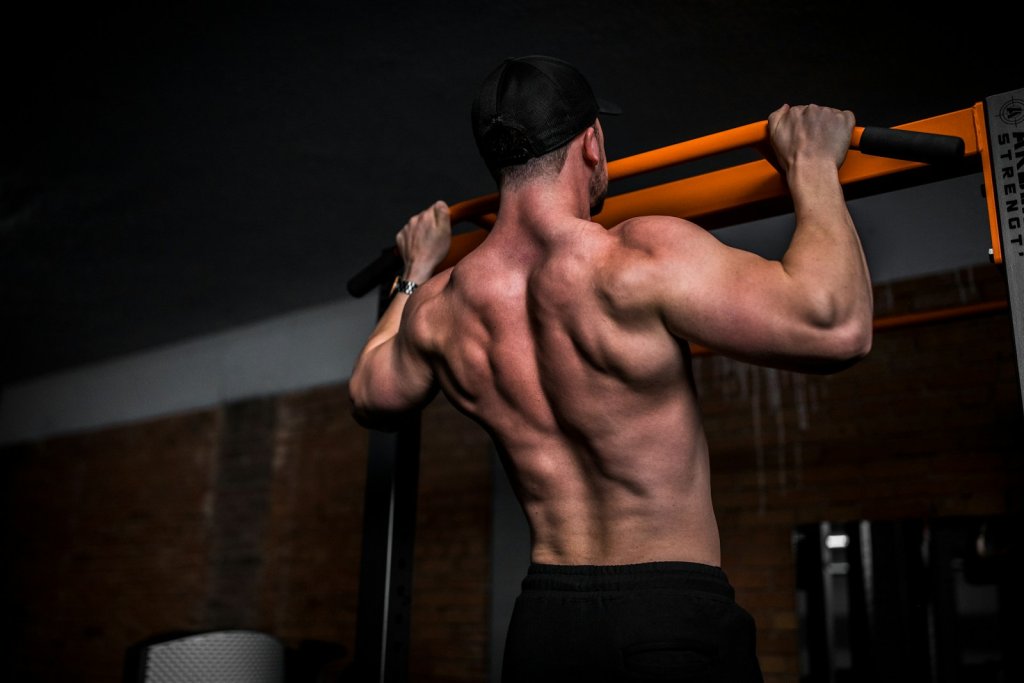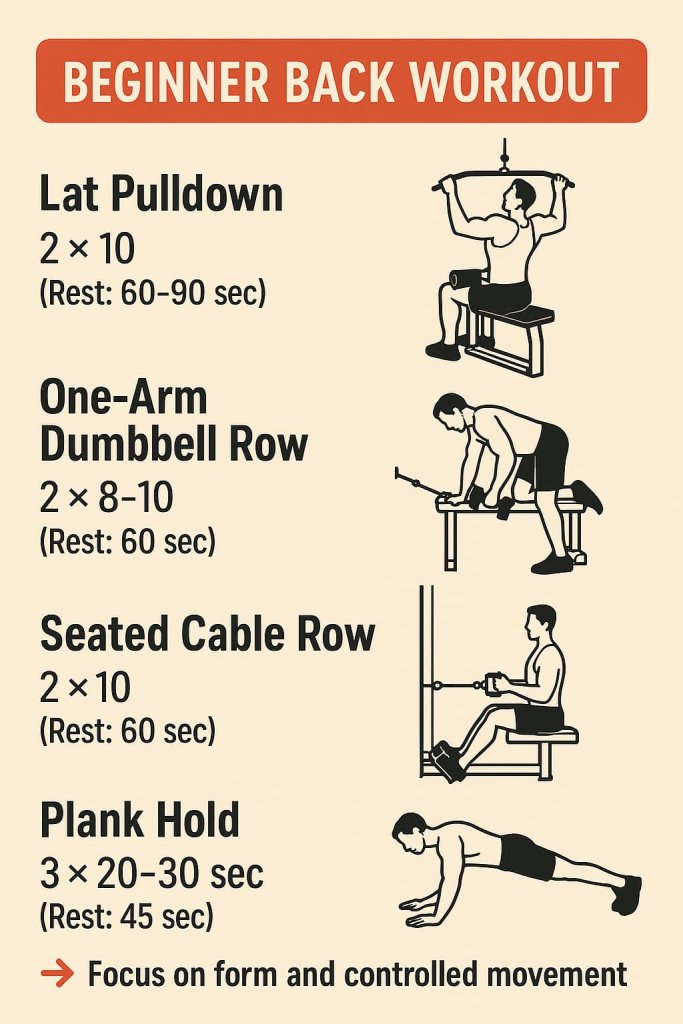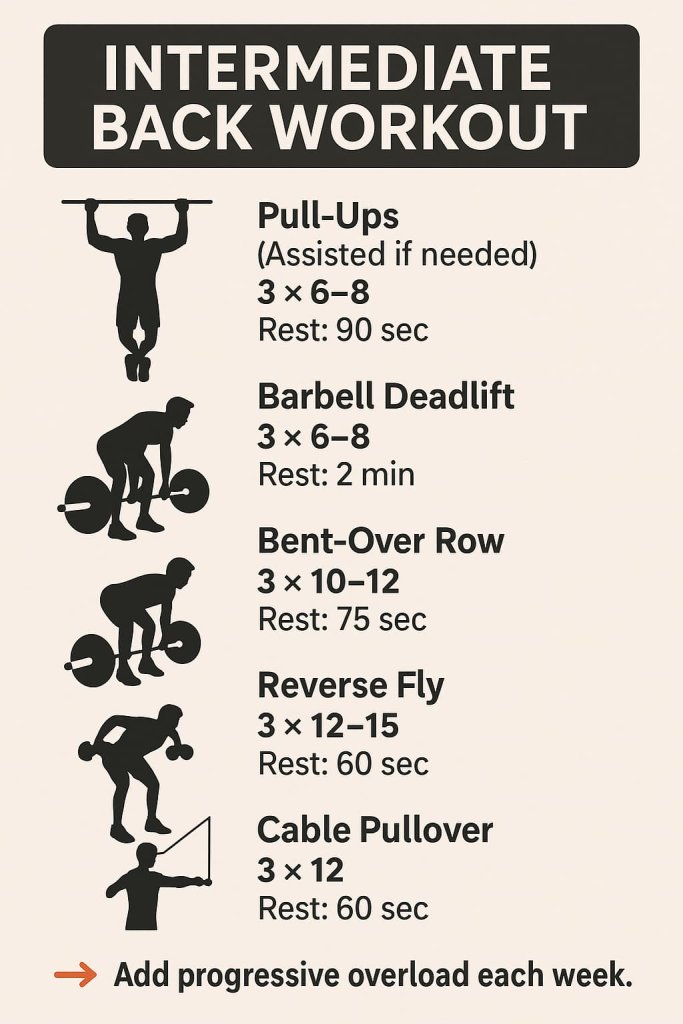The best back workout routine includes a mix of compound and isolation exercises such as pull-ups, rows, deadlifts, and reverse flys to build strength, width, and posture. Developing your back isn’t just about looking good—it’s essential for posture, injury prevention, and overall strength. Whether you’re a beginner or advanced lifter, the right back workout routine will help you target the lats, traps, rhomboids, and spinal erectors effectively.

In this guide, you’ll learn the best back exercises, beginner-to-advanced workout plans, benefits, and expert tips—all backed by the latest fitness research and authoritative sources.
Why Back Workouts Are Important
A strong back provides far more than aesthetics:
- Improves posture: Counteracts slouching and forward shoulder roll.
- Enhances strength: Supports heavy lifts like bench press and squats.
- Prevents injuries: Strengthens stabilizing muscles around the spine.
- Boosts performance: Increases pulling power for sports and daily activities.
According to Muscle & Fitness (2025), a well-rounded back routine should target the upper/outer lats, mid-back, lower back, and traps for balanced development.
Key Muscles Worked in Back Training
- Latissimus Dorsi (Lats): V-shaped muscles that add width.
- Trapezius (Traps): Extend from the neck to mid-back; important for posture.
- Rhomboids: Between the shoulder blades; crucial for scapular stability.
- Erector Spinae: Deep muscles along the spine; keep your back strong.
- Teres Major & Minor: Assist with pulling and shoulder movement.
Best Back Exercises (Science-Backed)
1. Pull-Ups (or Lat Pulldown)
Targets: Lats, biceps, traps.
ACE (American Council on Exercise) research confirms pull-ups are among the top muscle activators for the back.
2. Deadlifts
Targets: Entire posterior chain (lower back, glutes, hamstrings).
Considered the “king” of strength-building moves.
3. Bent-Over Rows (Barbell or Dumbbell)
Builds thickness in the mid-back.
Variations: Overhand (traps/lats), Underhand (biceps focus).
4. Single-Arm Dumbbell Row
Allows full range of motion and unilateral balance.
5. Seated Cable Row
Maintains constant tension and corrects muscular imbalances.
6. Face Pulls & Reverse Flys
Strengthen the rear delts and rhomboids—important for posture.
7. Back Extensions (Roman Chair)
Strengthens the erector spinae and prevents lower-back injury.
Back Workout Routines by Level
Beginner Back Workout

| Exercise | Sets × Reps | Rest |
|---|---|---|
| Lat Pulldown | 2 × 10 | 60–90 sec |
| One-Arm Dumbbell Row | 2 × 8–10 | 60 sec |
| Seated Cable Row | 2 × 10 | 60 sec |
| Plank Hold | 3 × 20–30 sec | 45 sec |
👉 Focus on form and controlled movement.
Intermediate Back Workout

| Exercise | Sets × Reps | Rest |
|---|---|---|
| Pull-Ups (Assisted if needed) | 3 × 6–8 | 90 sec |
| Barbell Deadlift | 3 × 6–8 | 2 min |
| Bent-Over Row | 3 × 10–12 | 75 sec |
| Reverse Fly | 3 × 12–15 | 60 sec |
| Cable Pullover | 3 × 12 | 60 sec |
👉 Add progressive overload each week.
Advanced Back Workout (Mass & Strength)
| Exercise | Sets × Reps | Rest |
|---|---|---|
| Weighted Pull-Ups | 4 × 6–8 | 90 sec |
| Barbell Deadlift | 4 × 5 | 2–3 min |
| T-Bar Row | 4 × 8–10 | 90 sec |
| One-Arm Dumbbell Row | 3 × 10 | 75 sec |
| Face Pull | 4 × 12–15 | 60 sec |
| Hyperextension | 3 × 12–15 | 60 sec |
👉 Cycle between heavy and hypertrophy-focused days for maximum growth.
Tips for an Effective Back Workout
- Warm-Up First: Dynamic stretches, bird-dogs, and light rows.
- Train Full Range: Don’t use partial reps—stretch and squeeze fully.
- Mix Grips: Wide, narrow, and underhand grips recruit different fibers.
- Balance Push & Pull: Keep back training equal to chest/shoulders to avoid imbalances.
- Include Bodyweight Work: Inverted rows are joint-friendly and safe for all levels.
Back Workout Benefits Beyond Muscle
According to Health.com (2025), consistent back workouts improve spinal stability, reduce lower-back pain, and enhance athletic movement【web】. This makes them vital for both fitness enthusiasts and desk workers.
FAQs
1. How many times a week should I train my back?
2–3 times per week is optimal for most people.
2. Should I do deadlifts every back workout?
No—deadlifts are taxing; 1× per week is enough for most.
3. Can I build a wide back without pull-ups?
Yes—lat pulldowns, rows, and pullovers can replace them effectively.
4. How long does it take to see results?
4–6 weeks for strength gains; 8–12 weeks for visible changes.
5. Are back workouts safe for people with lower-back pain?
Yes, if you focus on bodyweight and resistance-band moves—consult a physiotherapist first.
6. Do back workouts help posture?
Yes—strengthening rhomboids and traps directly improves posture.
7. Can women follow the same back workout routine?
Absolutely—only adjust weight and volume as needed.
Conclusion
A well-structured back workout routine is the key to strength, posture, and a V-tapered physique. By combining compound lifts like pull-ups and deadlifts with isolation moves like face pulls, you’ll train all areas of the back effectively.
👉 Start today with the beginner plan, progress to intermediate and advanced routines, and keep improving week by week. Your back will not only look powerful but also protect you from injuries and boost your daily performance.
